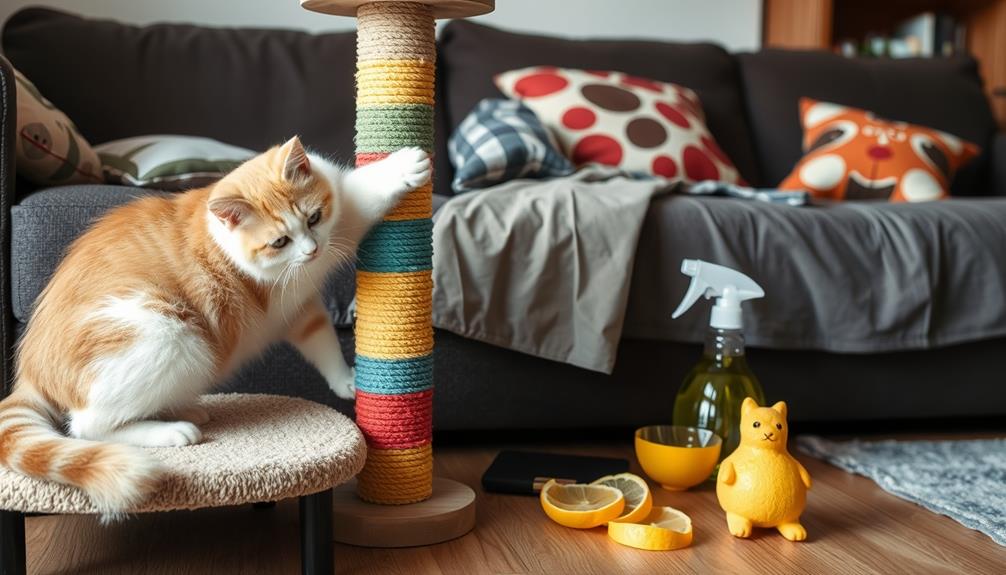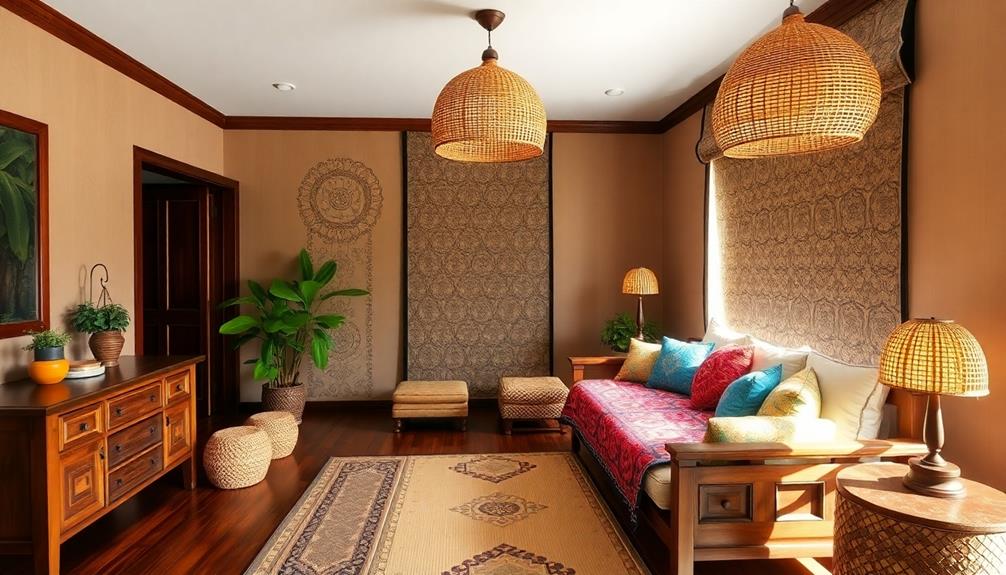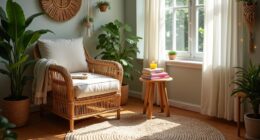To prevent your cat from scratching furniture, it is important to recognize that it is a natural instinct for them. Providing scratching posts and boards in different textures and locations can help encourage their use. You can also make your furniture less appealing by covering it with sheets or using double-sided tape on surfaces to create an unpleasant texture. Regularly trimming your cat’s nails can help minimize potential damage. Engaging in interactive play can also reduce anxiety and boredom, which can lead to scratching. There are many effective strategies to consider in order to maintain a harmonious relationship with your beloved feline companion.
Key Takeaways
- Provide a variety of scratching alternatives, such as posts, boards, and mats, to redirect scratching behavior away from furniture.
- Use positive reinforcement techniques to encourage your cat to use designated scratching areas.
- Make furniture less attractive by applying double-sided tape or cat-safe sprays to deter scratching.
- Regularly trim your cat's nails to minimize sharpness and reduce potential damage to furniture.
- Address anxiety and boredom through interactive playtime and calming supplements to promote a peaceful environment.
Understanding Cat Scratching Behavior
When you watch your cat scratch, it's important to understand that this behavior is instinctual and serves multiple purposes. Cats scratch to maintain their claw health by shedding old claw covers, which exposes sharp new surfaces. This is essential for their overall well-being.
Additionally, scratching allows your feline to mark territory; their paws contain scent glands that leave both visual and chemical markers on surfaces. Understanding the key domains of development in animals can help pet owners grasp the significance of instinctual behaviors.
Scratching also fulfills a physical need for exercise and stretching, helping relieve muscle tension and anxiety. While many cats prefer vertical scratching surfaces, individual cat preference varies, so it's important to pay attention to your cat's specific habits.
If your cat frequently scratches furniture, it may be a sign of stress or boredom, indicating they need enrichment.
To prevent damage, consider providing a dedicated scratching post instead of just allowing them to scratch your furniture. Offering various scratching options that cater to your cat's preferences can help redirect their natural instincts.
Training and Management Strategies

To effectively manage your cat's scratching habits, start by providing a variety of scratching alternatives, like posts made from different materials.
Offering options such as cardboard, sisal, and carpet can appeal to your cat's natural instincts to scratch and play, ensuring they've a suitable outlet.
Use positive reinforcement techniques, such as treats or praise, to encourage your cat to use these designated areas.
This approach not only protects your furniture but also promotes healthy behaviors in your feline friend.
For additional tips on pet care, consider exploring hamster care costs.
Provide Scratching Alternatives
Providing your cat with suitable scratching alternatives is essential for preserving your furniture while keeping your feline friend happy. Start by offering a variety of scratching posts made from materials like sisal, wood, or fabric to cater to your cat's preferred scratching style. Position these posts in high-traffic areas and near favorite furniture to encourage your cat to scratch them instead.
Here are some effective scratching alternatives to take into account:
| Scratching Alternative | Description |
|---|---|
| Vertical Scratching Post | Tall and sturdy for full-body stretching |
| Horizontal Scratching Board | Flat surface that mimics flooring |
| Textured Mat | Provides varied surfaces for scratching |
| DIY Scratching Options | Create your own using cardboard or fabric |
Experiment with different types to see which your cat enjoys the most. Regularly trim your cat's nails to minimize damage during their scratching sessions. By providing these options and encouraging your cat to scratch them, you'll help redirect their furniture scratching behavior and keep both your home and your cat content.
Positive Reinforcement Techniques
Using positive reinforcement techniques can effectively encourage your cat to choose scratching posts over furniture. Start by rewarding your cat with high-value treats and praise immediately after they use the scratching post. This reinforces the desired behavior and makes them associate the post with positive experiences.
Additionally, understanding your cat's behavior can be essential for successful training, much like recognizing the importance of selecting the right cold medication for effective relief in human health cold medications overview.
To maximize effectiveness, consider these strategies:
- Redirect your cat's attention to the scratching post whenever they approach furniture.
- Use consistent rewards like treats or affection each time they scratch the post.
- Guarantee consistency among all household members in applying the same rules and rewards.
- Introduce alternatives like textured mats or boards, rewarding your cat for exploring these new options.
- Incorporate interactive play sessions to engage your cat's natural instincts, reducing boredom and the urge to scratch furniture.
Providing Alternative Scratching Surfaces

Cats naturally need to scratch, so offering alternative surfaces is crucial for preserving your furniture. Start by providing tall and sturdy scratching posts made from materials like sisal, fabric, or wood. Position these posts near your cat's favorite furniture or high-traffic areas to increase the chances they'll use them. This will help redirect their scratching behavior effectively.
Consider incorporating horizontal scratching boards that mimic your flooring material, as some cats prefer horizontal scratching. These boards can be a great alternative scratching surface that suits their natural instincts. Additionally, using textured floor mats can attract your cat for scratching and is an affordable option that protects your furniture while allowing their claws to engage effectively.
If you have multiple cats, make sure to provide several scratching options to reduce competition for resources. This will help promote healthy scratching habits among all your pets and guarantee everyone has a designated spot to scratch.
Making Furniture Less Attractive

After setting up alternative scratching surfaces, you'll want to make your furniture less appealing to your pets. You can do this through a few effective strategies that deter cats from scratching. Here are some tips to take into account: First, you can try covering your furniture with double-sided tape or aluminum foil, as most cats do not like the feeling of these materials on their paws. Another strategy is to use deterrent sprays that have unpleasant scents or tastes for cats, such as citrus or bitter apple. Additionally, regularly trimming your cat’s nails and providing them with plenty of toys and scratching posts can go a long way in preventing cat scratches.
- Cover your furniture with sheets, plastic covers, or aluminum foil to create an undesirable texture.
- Apply double-sided sticky tape to targeted areas; cats usually dislike the sticky feeling, making them think twice before scratching.
- Use cat-safe citrus or vinegar sprays to create an aversive smell that keeps cats away from your furniture.
- Regularly clean your furniture to remove scent marks, which can attract cats and encourage them to scratch.
- Drape decorative blankets or throws over your furniture to protect surfaces and minimize visible claw marks, making the area less inviting.
Addressing Anxiety and Stress

To effectively address your cat's scratching, you need to recognize what triggers their anxiety.
Once you identify these stressors, consider calming supplements like pheromone diffusers to help ease their nerves.
Recognizing Anxiety Triggers
Recognizing anxiety triggers in your feline friend can be essential for preventing unwanted scratching and promoting a peaceful environment. By identifying what stresses your cat, you can tailor your approach to minimize anxiety and reduce destructive behaviors.
Common anxiety triggers include:
- Loud noises, like thunderstorms or fireworks
- Changes in routine, such as moving or new schedules
- Introduction of new pets or people
- Lack of environmental enrichment, leading to boredom
- Illness or discomfort, which may manifest as anxiety
To address these triggers, you can provide environmental enrichment and regular interactive playtime, which helps to engage your cat mentally and physically.
Additionally, seeking behavioral support from a Certified Applied Animal Behaviorist can provide valuable insights into your cat's specific needs. They can recommend effective strategies to help your cat cope with anxiety, possibly including calming supplements to create a more comforting atmosphere.
Calming Supplements Options
When it comes to easing your cat's anxiety and stress, calming supplements can be a game-changer. These products, like L-theanine and valerian root, promote relaxation, which can help reduce anxiety in cats and minimize destructive scratching behavior.
You'll find calming supplements in various forms, such as treats, powders, and liquids, making it easy to fit them into your cat's daily routine.
Don't forget to consult your veterinarian for tailored recommendations, as each cat's needs may vary based on their temperament and any underlying issues.
Besides supplements, consider using calming sprays that contain pheromones. These mimic natural feline scents and can create a soothing environment, further deterring anxious scratching.
Combining regular use of calming supplements with environmental enrichment—like interactive toys, scratching posts, and cozy resting spots—can lead to a more balanced and less stressed cat.
This holistic approach not only helps in managing anxiety in cats but also considerably reduces the likelihood of them scratching your furniture.
Regular Nail Care Practices

Maintaining your cat's nails is a crucial step in protecting your furniture from scratches. Regularly trimming your cat's nails every 2-4 weeks minimizes sharpness and reduces potential damage.
Using a quality cat nail trimmer or grinder allows for the safe removal of the sharp tips without causing discomfort. Here are some essential practices to take into account:
- Familiarize your cat with nail trimming from a young age, ideally starting at around 8 weeks.
- Make certain the trimming process is calm and positive by using treats and praise.
- Think about applying claw caps, like Soft Paws, to provide a protective barrier against scratches while allowing natural claw extension.
- Regularly trimming won't only keep your furniture safe but also promote your cat's comfort and well-being.
- If your cat resists nail trimming, try incorporating it into a routine, making it a part of your bonding time.
Effective Use of Deterrents

Deterring your cat from scratching furniture can be achieved through several effective methods. One of the simplest techniques is applying double-sided tape to the surfaces you want to protect. Cats generally dislike the sticky texture on their paws, making it a great deterrent.
You can also use cat-safe citrus or vinegar sprays on your furniture, as the aversive smell can discourage them from scratching those areas.
Consider investing in motion-activated air sprays. These devices release a burst of air when your cat approaches, effectively redirecting them away from the furniture.
Additionally, Feliway pheromone spray can help reduce anxiety and deter scratching on new items by mimicking natural feline facial pheromones, making the area feel less threatening.
Don't forget the importance of regularly cleaning furniture to eliminate any scent marks left by your cat. By removing these familiar territorial signals, you can greatly reduce their urge to scratch.
Combining these strategies will create an all-encompassing approach to deterring scratching and keeping your furniture intact.
Understanding Declawing Consequences

Declawing, often misunderstood as a simple solution for managing scratching, has serious and painful consequences for cats. This surgical procedure involves amputating the last bone of each toe, leading to chronic pain and discomfort.
Many cities and countries have recognized the ethical implications of declawing and banned the practice due to its negative impact on a cat's physical and mental health.
Consider these consequences before opting for declawing:
- Increased biting and aggression as a cat loses a primary means of defense.
- Litter box avoidance due to discomfort or inability to scratch properly.
- Mobility issues, making it difficult for your cat to climb or engage in normal activities.
- Changes in cat behavior, causing stress and anxiety without their claws.
- Ineffective long-term solution, as alternatives exist that respect your cat's well-being.
Instead of declawing, focus on providing your cat with scratching posts and using regular nail trimming or claw caps.
These alternatives allow your cat to use their natural behaviors without suffering harm. Remember, keeping your furniture safe shouldn't come at the cost of your cat's health.
Seeking Professional Help

When dealing with your cat's scratching behavior, seeking professional help can make a significant difference. Consulting with a Certified Applied Animal Behaviorist can provide tailored strategies to address not just the scratching but any underlying anxiety issues your cat might have.
These professionals can assess your situation and recommend specific approaches that fit your cat's personality and environment.
If you notice your cat scratching excessively, it's crucial to take into account that anxiety could be a factor. Veterinary professionals can prescribe calming supplements or medications to help manage these anxiety symptoms, ensuring a safe and effective treatment plan.
Engaging in telehealth consultations can also be incredibly beneficial. This allows you to get immediate veterinary advice without the stress of a clinic visit.
Additionally, exploring pet care resources, including articles and community support groups, can offer you further insights and strategies tailored to your cat's needs.
Regular follow-ups with professionals can help monitor your cat's progress and adapt strategies as necessary, ensuring long-term success in managing scratching behavior.
Don't hesitate to reach out for help; your cat's well-being is worth it.
Frequently Asked Questions
What Deters Cats From Scratching Furniture?
To deter cats from scratching furniture, try using sticky tape on surfaces, applying cat-safe deterrent sprays, and providing scratching posts. Positive reinforcement and protective covers can also redirect their behavior effectively.
How Do I Stop My Cat From Scratching My Couch?
You don't want your precious couch to become a cat's personal playground. Instead, create a cozy scratching haven nearby, use deterrents, and reward your feline for choosing the right spot to stretch those claws.
How Do You Scratch Proof Furniture From Cats?
To scratch-proof your furniture, use clear shields, sticky tape, and sturdy scratching posts nearby. Apply pheromone sprays, and trim your cat's claws regularly. These steps will help protect surfaces while redirecting your cat's behavior.
What Can I Spray on My Sofa to Stop My Cat Scratching It?
Imagine a brave knight defending a castle. You can spray your sofa with deterrents like citrus or Bitter Apple. These repelling scents act as your shield, keeping your feline foe from scratching your cherished furniture.
Conclusion
To summarize, keeping your cat from scratching your furniture takes patience and understanding. Remember, "You can't teach an old dog new tricks," but cats can learn with the right approach. By providing alternative scratching surfaces, using effective deterrents, and addressing any anxiety, you'll create a happier environment for both of you. Regular nail care and training will make a significant difference, helping to preserve your furniture while ensuring your cat feels secure and fulfilled.









